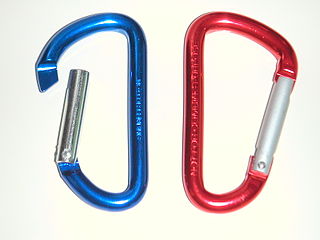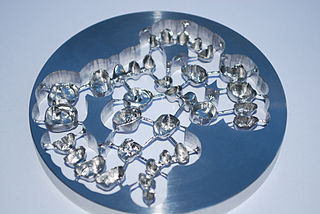Related Research Articles
Carbon compounds are defined as chemical substances containing carbon. More compounds of carbon exist than any other chemical element except for hydrogen. Organic carbon compounds are far more numerous than inorganic carbon compounds. In general bonds of carbon with other elements are covalent bonds. Carbon is tetravalent but carbon free radicals and carbenes occur as short-lived intermediates. Ions of carbon are carbocations and carbanions are also short-lived. An important carbon property is catenation as the ability to form long carbon chains and rings.

A metal is a material that, when freshly prepared, polished, or fractured, shows a lustrous appearance, and conducts electricity and heat relatively well. Metals are typically malleable or ductile. A metal may be a chemical element such as iron; an alloy such as stainless steel; or a molecular compound such as polymeric sulfur nitride.

Molybdenum is a chemical element with the symbol Mo and atomic number 42. The name is from Neo-Latin molybdaenum, which is based on Ancient Greek Μόλυβδος molybdos, meaning lead, since its ores were confused with lead ores. Molybdenum minerals have been known throughout history, but the element was discovered in 1778 by Carl Wilhelm Scheele. The metal was first isolated in 1781 by Peter Jacob Hjelm.

Rust is an iron oxide, a usually reddish-brown oxide formed by the reaction of iron and oxygen in the catalytic presence of water or air moisture. Rust consists of hydrous iron(III) oxides (Fe2O3·nH2O) and iron(III) oxide-hydroxide (FeO(OH), Fe(OH)3), and is typically associated with the corrosion of refined iron.

Group 6, numbered by IUPAC style, is a group of elements in the periodic table. Its members are chromium (Cr), molybdenum (Mo), tungsten (W), and seaborgium (Sg). These are all transition metals and chromium, molybdenum and tungsten are refractory metals.

Corrosion is a natural process that converts a refined metal into a more chemically stable form such as oxide, hydroxide, carbonate or sulfide. It is the gradual destruction of materials by chemical and/or electrochemical reaction with their environment. Corrosion engineering is the field dedicated to controlling and preventing corrosion.
Passivation, in physical chemistry and engineering, refers to coating a material so it becomes "passive," that is, less readily affected or corroded by the environment. Passivation involves creation of an outer layer of shield material that is applied as a microcoating, created by chemical reaction with the base material, or allowed to build by spontaneous oxidation in the air. As a technique, passivation is the use of a light coat of a protective material, such as metal oxide, to create a shield against corrosion. Passivation of silicon is used during fabrication microelectronic devices. In electrochemical treatment of water, passivation reduces the effectiveness of the treatment by increasing the circuit resistance, and active measures are typically used to overcome this effect, the most common being polarity reversal, which results in limited rejection of the fouling layer.
Refractory metals are a class of metals that are extraordinarily resistant to heat and wear. The expression is mostly used in the context of materials science, metallurgy and engineering. The definition of which elements belong to this group differs. The most common definition includes five elements: two of the fifth period and three of the sixth period. They all share some properties, including a melting point above 2000 °C and high hardness at room temperature. They are chemically inert and have a relatively high density. Their high melting points make powder metallurgy the method of choice for fabricating components from these metals. Some of their applications include tools to work metals at high temperatures, wire filaments, casting molds, and chemical reaction vessels in corrosive environments. Partly due to the high melting point, refractory metals are stable against creep deformation to very high temperatures.

Anodizing is an electrolytic passivation process used to increase the thickness of the natural oxide layer on the surface of metal parts.
Plating is a surface covering in which a metal is deposited on a conductive surface. Plating has been done for hundreds of years; it is also critical for modern technology. Plating is used to decorate objects, for corrosion inhibition, to improve solderability, to harden, to improve wearability, to reduce friction, to improve paint adhesion, to alter conductivity, to improve IR reflectivity, for radiation shielding, and for other purposes. Jewelry typically uses plating to give a silver or gold finish.

Pitting corrosion, or pitting, is a form of extremely localized corrosion that leads to the random creation of small holes in metal. The driving power for pitting corrosion is the depassivation of a small area, which becomes anodic while an unknown but potentially vast area becomes cathodic, leading to very localized galvanic corrosion. The corrosion penetrates the mass of the metal, with a limited diffusion of ions.

Chromate conversion coating or alodine coating is a type of conversion coating used to passivate steel, aluminium, zinc, cadmium, copper, silver, titanium, magnesium, and tin alloys. The coating serves as a corrosion inhibitor, as a primer to improve the adherence of paints and adhesives, as a decorative finish, or to preserve electrical conductivity. It also provides some resistance to abrasion and light chemical attack on soft metals.
A Conversion coating is a chemical or electro-chemical treatment applied to manufactured parts that superficially converts the material into a thin adhering coating of an insoluble compound. These coatings are commonly applied to protect the part against corrosion, to improve the adherence of other coatings, for lubrication or for decoration.
The military specification referred to as MIL-DTL-5541, "Military Specification, Chemical Conversion Coatings on Aluminum and Aluminum Alloys" covers chemical conversion coatings formed by the reaction of chemical conversion materials with the surfaces of aluminum and aluminum alloys. The current specification (2009) is MIL-DTL-5541F, which superseded MIL-C-5541E in July 2006. The specification is approved for use by all departments and agencies of the United States Department of Defense (DoD). Although prepared specifically for DoD applications, the standard is used for many commercial applications as well. It has gained world wide use across many fields versus the more verbose ISO equivalent. Note that chromate conversion coatings have been used for over 50 years as treatment to coated or as-fabricated surfaces to boost corrosion resistance and provide a good basis for the subsequent application of paint. However, these treatments use hexavalent chromium chemicals that are extremely toxic. This has led to progressively greater restrictions, imposed by national and international legislation, related to concerns over health and safety and environmental protection, on the use of these treatments.
Alloy steel is steel that is alloyed with a variety of elements in total amounts between 1.0% and 50% by weight to improve its mechanical properties. Alloy steels are broken down into two groups: low alloy steels and high alloy steels. The difference between the two is disputed. Smith and Hashemi define the difference at 4.0%, while Degarmo, et al., define it at 8.0%. Most commonly, the phrase "alloy steel" refers to low-alloy steels.
Dry lubricants or solid lubricants are materials that, despite being in the solid phase, are able to reduce friction between two surfaces sliding against each other without the need for a liquid oil medium.

Cobalt-chrome or cobalt-chromium (CoCr) is a metal alloy of cobalt and chromium. Cobalt-chrome has a very high specific strength and is commonly used in gas turbines, dental implants, and orthopedic implants.
Alonizing is a diffusion metallizing process in that it is a thermochemical treatment that involves enriching the surface layer of an object with one or more metallic elements. Specifically, alonizing is the diffusion of aluminum into the surface of a base metal through high temperature vapors. The types of metals that can be alonized include all types of wrought and cast steels. This process results in an alloy with the surface properties of aluminum while retaining the base metal's inherent strength and rigidity. Therefore, alonizing does not change the high-temperature mechanical properties of the base metal, which is the advantage of alonizing over simply creating an aluminum alloy.
References
- ↑ Sillitoe, Richard H. (2010). "Porphyry copper systems". Economic Geology. 105 (1): 3–41. doi : 10.2113/gsecongeo.105.1.3
- ↑ McKamey, C. G.; DeVan, J. H.; Tortorelli, P. F.; Sikka, V. K. (1991). "A review of recent developments in iron-aluminum (Fe3Al)-based alloys". Journal of Materials Research. 6 (8): 1779–805. doi : 10.1557/JMR.1991.1779
- ↑ Van der Vlies (2002). "Chemical principles of the sulfidation reaction of tungsten oxides" (PDF). Swiss Federal Institute of Technology Zurich.
- 1 2 Liang, Yan-Jie; Chai, Li-Yuan; Liu, Hui; Min, Xiao-Bo; Mahmood, Qaisar; Zhang, Hai-Jing; Ke, Yong (2012). "Hydrothermal sulfidation of zinc-containing neutralization sludge for zinc recovery and stabilization". Minerals Engineering. 25: 14. doi:10.1016/j.mineng.2011.09.014.
- ↑ Zeng, Qun-Feng; Dong, Guang-Neng; Xie, You-bai (2008). "Influence of sulfidation treatment on the structure and tribological properties of nitrogen-doped diamond-like carbon films". Applied Surface Science. 254 (13): 3859. Bibcode:2008ApSS..254.3859Z. doi:10.1016/j.apsusc.2007.12.010.